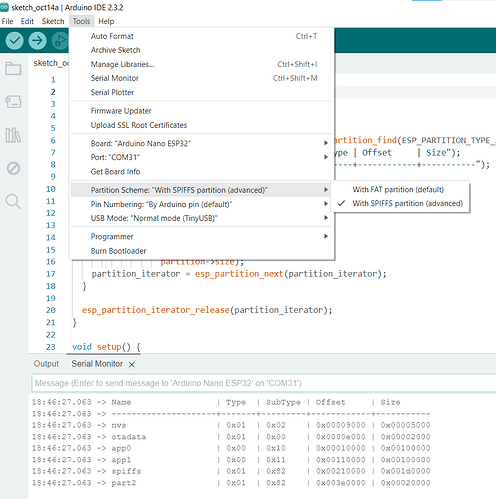Hi,
I try to modify the partitions table for my Arduine Nano ESP32S3 project, without any success. My file is in the partitions directory, as a partitions.csv and it is the following:
Name, Type, SubType, Offset, Size, Flags
nvs, data, nvs, 0x9000, 0x6000,
otadata, data, ota, 0xf000, 0x2000,
app0, app, ota_0, 0x20000, 0x600000,
app1, app, ota_1, 0x620000, 0x600000,
spiffs, data, spiffs, 0xc20000, 0x300000,
It is also set in the platformio.ini as:
[env:arduino_nano_esp32]
platform = espressif32
board = arduino_nano_esp32
framework = arduino
monitor_speed = 115200
board_build.mcu = esp32s3
board_build.filesystem = littlefs
board_build.flash_size = 16MB
board_build.partitions = partitions/partitions.csv
The compiler finds this csv file, because when I used the littlefs name instead of the spiffs in the file, I got an error message. Changing to spiffs the project builds smoothly and I can download it. When however I run a small reporting program on the ESP about the existing partitions, I got a completely different setup, as:
=== Application Partitions ===
Name: app0, Type: 0x0, SubType: 0x10, Offset: 0x10000, Size: 0x100000
Name: app1, Type: 0x0, SubType: 0x11, Offset: 0x110000, Size: 0x100000
=== Data Partitions ===
Name: nvs, Type: 0x1, SubType: 0x2, Offset: 0x9000, Size: 0x5000
Name: otadata, Type: 0x1, SubType: 0x0, Offset: 0xe000, Size: 0x2000
Name: spiffs, Type: 0x1, SubType: 0x82, Offset: 0x210000, Size: 0x1d0000
Name: part2, Type: 0x1, SubType: 0x82, Offset: 0x3e0000, Size: 0x20000
I have no idea from this setup arises, as this is not my intendent setup and not any of the setups defined in the .platformio\packages\framework-arduinoespressif32\tools\partitions library.
Does anybody have the idea from where the compiler gets this partition scheme?
Thanks in advance!
